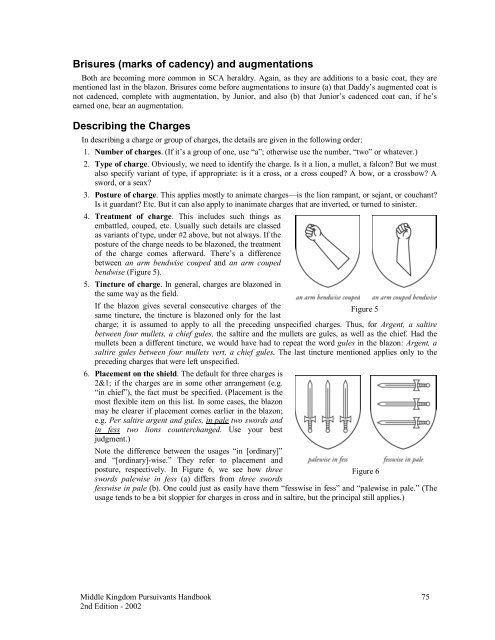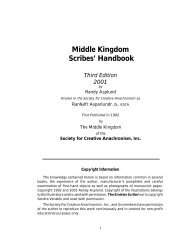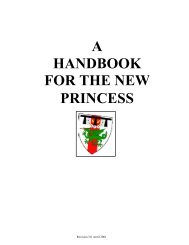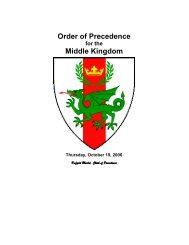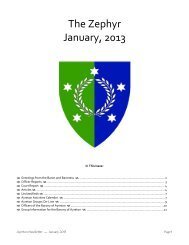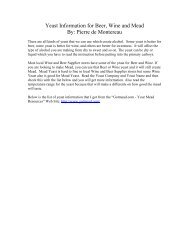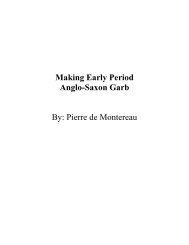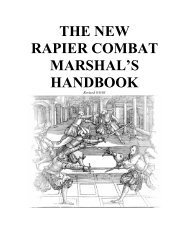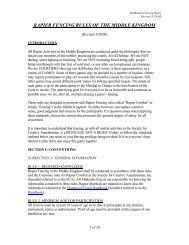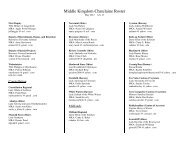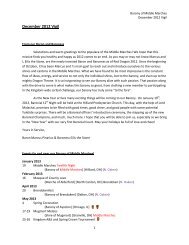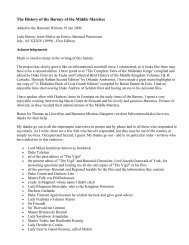Figure 3Primary chargesThis is the central, visually dominant group of charges. Usually, if there is a central ordinary, it will be theprimary charge.If there are several charges in any one group, they are blazoned in order from the field up; from the centerout; from chief to base; and from dexter to sinister—the first rule that applies to a given device. See fig.4 forexamples of each hierarchy of blazon. (This applies as well to other groups of charges. For instance, in the armsOr, a bend between a blivet and a hufnagel gules, the blivet is in chief.)Figure 4Secondary and tertiary chargesThese are blazoned after the primary charges for historical reasons. In the 12th and 13th Centuries,secondaries and tertiaries were added to a device as a form of cadency. If a blazon were recorded for the mainbranch of the family, the added charges could simply be appended to the blazon as written. Thus, the arms ofGrandison, Paly argent and azure, a bend gules, could be easily modified for cadet branches by adding thephrase and on the bend three eagles Or (or three escallops Or, or three buckles Or, depending on the branch ofthe family).Peripheral secondary chargesThis includes the chief, the bordure and the canton, among others. Though ordinaries, they were not first inthe blazon, for the same reason given above: they were often additions to the device, and medieval heralds didnot have word processors to permit easy amendments to recorded blazons.If both a bordure and a chief are used, the bordure is blazoned first; the chief then follows the bordure.Cantons are blazoned last of all. If they have tertiary charges, those are blazoned along with the secondary: i.e.first the bordure, then the tertiaries on the bordure, then the chief, then the tertiaries on the chief. (More thanthat is probably too busy to be registered, but one never knows )74 <strong>Middle</strong> <strong>Kingdom</strong> <strong>Pursuivants</strong> <strong>Handbook</strong><strong>2nd</strong> <strong>Edition</strong> - 2002
Brisures (marks of cadency) and augmentationsBoth are becoming more common in SCA heraldry. Again, as they are additions to a basic coat, they arementioned last in the blazon. Brisures come before augmentations to insure (a) that Daddy’s augmented coat isnot cadenced, complete with augmentation, by Junior, and also (b) that Junior’s cadenced coat can, if he’searned one, bear an augmentation.Describing the ChargesIn describing a charge or group of charges, the details are given in the following order:1. Number of charges. (If it’s a group of one, use “a”; otherwise use the number, “two” or whatever.)2. Type of charge. Obviously, we need to identify the charge. Is it a lion, a mullet, a falcon? But we mustalso specify variant of type, if appropriate: is it a cross, or a cross couped? A bow, or a crossbow? Asword, or a seax?3. Posture of charge. This applies mostly to animate charges—is the lion rampant, or sejant, or couchant?Is it guardant? Etc. But it can also apply to inanimate charges that are inverted, or turned to sinister.4. Treatment of charge. This includes such things asembattled, couped, etc. Usually such details are classedas variants of type, under #2 above, but not always. If theposture of the charge needs to be blazoned, the treatmentof the charge comes afterward. There’s a differencebetween an arm bendwise couped and an arm coupedbendwise (Figure 5).5. Tincture of charge. In general, charges are blazoned inthe same way as the field.If the blazon gives several consecutive charges of theFigure 5same tincture, the tincture is blazoned only for the lastcharge; it is assumed to apply to all the preceding unspecified charges. Thus, for Argent, a saltirebetween four mullets, a chief gules, the saltire and the mullets are gules, as well as the chief. Had themullets been a different tincture, we would have had to repeat the word gules in the blazon: Argent, asaltire gules between four mullets vert, a chief gules. The last tincture mentioned applies only to thepreceding charges that were left unspecified.6. Placement on the shield. The default for three charges is2&1; if the charges are in some other arrangement (e.g.“in chief”), the fact must be specified. (Placement is themost flexible item on this list. In some cases, the blazonmay be clearer if placement comes earlier in the blazon;e.g. Per saltire argent and gules, in pale two swords andin fess two lions counterchanged. Use your bestjudgment.)Note the difference between the usages “in [ordinary]”and “[ordinary]-wise.” They refer to placement andposture, respectively. In Figure 6, we see how threeFigure 6swords palewise in fess (a) differs from three swordsfesswise in pale (b). One could just as easily have them “fesswise in fess” and “palewise in pale.” (Theusage tends to be a bit sloppier for charges in cross and in saltire, but the principal still applies.)<strong>Middle</strong> <strong>Kingdom</strong> <strong>Pursuivants</strong> <strong>Handbook</strong> 75<strong>2nd</strong> <strong>Edition</strong> - 2002
- Page 2:
Middle Kingdom Pursuivants Handbook
- Page 5 and 6:
INTRODUCTION.......................
- Page 7 and 8:
Saracens: Early to Mid-Medieval Mus
- Page 9 and 10:
IntroductionOsric of FayrehopeWhat
- Page 11 and 12:
AcknowledgementsMistress Elena de V
- Page 13 and 14:
The Middle KingdomCollege of Herald
- Page 15 and 16:
Regional HeraldsConstellation Heral
- Page 17 and 18:
Pursuivant DutiesDuties of the Bran
- Page 19 and 20:
All submissions should be sent to t
- Page 21 and 22:
What to Report?First of all, your r
- Page 23 and 24:
esponsibility now. It wouldn’t hu
- Page 25 and 26:
simply too pervasive. Chilly weathe
- Page 27 and 28:
switched into the losers’ bracket
- Page 29 and 30:
prevent accusations of a rigged lis
- Page 31 and 32:
the green fabric), a larger spool o
- Page 33 and 34:
Precedence and CourtesyCourtly Beha
- Page 35 and 36: Territorial Barons and Baronesses m
- Page 37 and 38: c. Once all presentations appear to
- Page 39 and 40: i. Oaths of Fealty and Acknowledgem
- Page 41 and 42: herald is the voice of the Crown an
- Page 43 and 44: Award of the Dragon's FlightOP Abbr
- Page 45 and 46: Award of ArmsOP Abbreviation - AoAL
- Page 47 and 48: Order of the Red CompanyOP Abbrevia
- Page 49 and 50: Order of the WillowOP Abbreviation
- Page 51 and 52: Order of the Gold MaceOP Abbreviati
- Page 53 and 54: Master of ArmsOP Abbreviation - MSC
- Page 55 and 56: Prince and Princess of NorthshieldO
- Page 57 and 58: - The Consort of Northshield bears
- Page 59 and 60: The Submission ProcessWorking with
- Page 61 and 62: A good consultant will have these e
- Page 63 and 64: submit it anyway (“I may be wrong
- Page 65 and 66: Internal Letter Of Acceptance And R
- Page 67 and 68: NamesOn Names and Name Documentatio
- Page 69 and 70: Choosing a CultureJehan de la March
- Page 71 and 72: Clothing: For the Slavic groups, pr
- Page 73 and 74: Politics: The entire Islamic world
- Page 75 and 76: Although in the earlier Middle Ages
- Page 77 and 78: character in Household’s Arabesqu
- Page 79 and 80: An Extremely Brief BibliographyWest
- Page 81 and 82: ArmoryThe Philosophical Roots of He
- Page 83 and 84: Even if your natural instinct for a
- Page 85: 5. Peripheral secondary charges.6.
- Page 89 and 90: Still found in mundane blazons are
- Page 91 and 92: Efficient Conflict ResearchKeridwen
- Page 93 and 94: 1. Is there a peripheral charge (a
- Page 95 and 96: checking under the old rules, the s
- Page 97 and 98: 2. Yes, the peripheral is charged.
- Page 99 and 100: Many authors state that dancetty is
- Page 101 and 102: Charges may be placed on either sid
- Page 103 and 104: It’s a bit more complicated to ke
- Page 105 and 106: This page shows properly drawn exam
- Page 107 and 108: This page shows a number of common
- Page 109 and 110: Postures of Animals (cont’d)Posit
- Page 111 and 112: Postures of BirdsPosition & Comment
- Page 113 and 114: Postures of Fish and DolphinsPositi
- Page 115 and 116: Barony of Caer Anterth MawrAzure, a
- Page 117 and 118: Barony of the North WoodsAzure, a w
- Page 119 and 120: Shire of AfonlynAzure, on a bend ar
- Page 121 and 122: Shire of Rivenwood TowerErmine, on
- Page 123 and 124: Reference BooksThe Basic HeraldBron
- Page 125 and 126: Bardsley, Charles Wareing. English
- Page 127 and 128: Kaganoff, Benzion C. A Dictionary o
- Page 129 and 130: Sims, Clifford Stanley. The Origin
- Page 131 and 132: Moncreiffe, Iain, and Don Pottinger
- Page 133 and 134: Bruce Draconarius of Mistholme and
- Page 135 and 136: Rules and RegulationsRules for Subm
- Page 137 and 138:
Although China, Random and Starhawk
- Page 139 and 140:
iii. Heraldic Titles - Heraldic tit
- Page 141 and 142:
ii. Number of Name Phrases - A pers
- Page 143 and 144:
PART VII - COMPATIBLE ARMORIAL CONT
- Page 145 and 146:
i. A metal and a color;ii. An eleme
- Page 147 and 148:
PART IX - OFFENSIVE ARMORYOffensive
- Page 149 and 150:
ii. Field-Primary Armory - If neith
- Page 151 and 152:
j. Changes to Charges on Charges -
- Page 153 and 154:
3. Marshalling. - Armory that appea
- Page 155 and 156:
directly by individuals, but may be
- Page 157 and 158:
the Laurel Office from the registra
- Page 159 and 160:
charge or augmentation is transferr
- Page 161 and 162:
so that ð is alphabetized as dh,
- Page 163 and 164:
1. Failure to Comment. Failure to c
- Page 165 and 166:
B. Content of Letters of Acceptance
- Page 167 and 168:
1. Principal Heralds - The Principa
- Page 169 and 170:
1. Financial Reports - Financial re
- Page 171 and 172:
Appendix B - Standard Designations
- Page 173 and 174:
Appendix D - Suggested Standard For
- Page 175 and 176:
Appendix G - Role of the Deputy Sov
- Page 177 and 178:
Glossary of TermsThis glossary was
- Page 179 and 180:
Complement, In Her*—Describes the
- Page 181 and 182:
Fur—Some furs, like Vair, Potent
- Page 183 and 184:
Mon—Japanese armorial insignia†
- Page 185 and 186:
Registration—Acceptance by Laurel
- Page 187 and 188:
AppendicesSources for Heraldic Publ
- Page 189 and 190:
• Send the four copies in and kee
- Page 191 and 192:
“Major” or “minor” changes?
- Page 193 and 194:
See the General section at the begi


